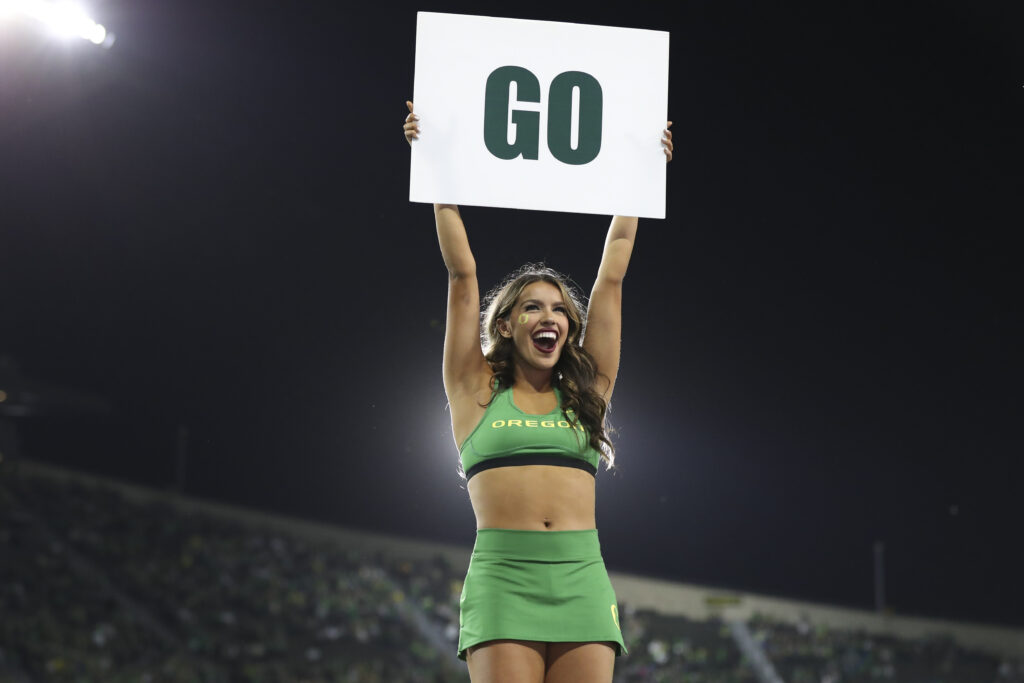The Pac-12’s existence seemingly hangs in the balance as the Big Ten considers whether to offer membership to Oregon, Washington and possibly Stanford and Cal, as well.
Does the conference want to create a West Coast division?
Or will it stand down and give the Pac-12 a chance to survive?
Resolution of this deeply complicated issue could come swiftly, perhaps in the next 48 hours.
After all, the Big Ten executed a West Coast raid last summer, grabbing USC and UCLA. The framework for a second round of plundering is seemingly in place, but only if proper motivation exists on two fronts:
— Finding a media company to pay for it.
— Rounding up enough university presidents to approve it.
For the past year, neither entity was interested. The networks didn’t have the money, and the presidents had no interest in driving a stake into the Pac-12.
But the situation changed this week, at least with one of the two entities.
The Big Ten presidents signaled a willingness to consider adding Washington, Oregon and the Bay Area schools because the Pac-12’s existential crisis provides the necessary cover. The presidents aren’t predators; they’re saviors. Instead of a stake, they’re offering a life raft.
But magnanimity is one thing. Cash is another, and the Big Ten schools won’t expand if it means giving up a dime of the money coming to them under the media rights agreement that begins this year.
That deal with Fox, NBC and CBS is expected to pay each school an average of approximately $65 million for the life of the seven-year deal.
Whatever cash the new members receive must come from a separate revenue stream.
In other words, the Big Ten would need one of the three current media partners to increase its payments to cover the costs of expansion, or it would need a fourth network to join the fray and handle the cost.
How much?
First, know this: Fox owns the Big Ten media rights through its majority stake in the Big Ten Network which, in turn, controls the league’s grant-of-rights agreement.
Any decisions on media partners and expansion run through Fox, which is essentially sub-licensing packages of games to CBS and NBC for the seven-year contract.
Second key point: Oregon, Washington, Stanford and Cal would not receive anything close to the $65 million allocated to the Big Ten’s 16 members (including USC and UCLA).
But even discounted shares would carry immense costs.
The Ducks and Huskies have bigger brands and better viewership numbers than Cal and Stanford and thus are worth more to Big Ten media partners.
Let’s say the Northwest powers agreed to a laddered revenue structure like this over the Big Ten’s contract:
Years 1-2: quarter share
Years 3-4: half share
Years 5-6: three-quarters share
Year 7: full share
That’s two years at $16.5 million, two more at $32.5 million, two more at $48.75 million and one year at $65 million, for a total of $260.5 million.
Multiply that times two schools, and a media company would need to shell out $521 million to make the math work for the Huskies and Ducks to enter the Big Ten at reduced revenue shares for the entirety of the seven-year contract cycle.
(Please note: Our numbers are estimates. The Big Ten’s contract includes an escalator clause, meaning the payments start well below the estimated average of $65 million average amount and end well above.)
If Stanford and Cal are included, the total is considerably higher. How much? It’s probably not double the cost of UW and Oregon, because the Bay Area schools don’t command the same market valuation as the Huskies and Ducks.
Let’s assign Stanford and Cal revenue shares equal to 75 percent of what UW and Oregon receive. That works out to $195.4 million per school.
For two schools, the bill exceeds $500 million over seven years.
For the four schools, the total approaches $1 billion.
But thanks to the Big Ten’s game-selection process, there could be an added complication.
The fourth media partner would not necessarily have priority picks.
For example, ESPN wouldn’t be guaranteed weekly high-level matchups involving Washington and Oregon just because it paid for Washington and Oregon, according to an industry source with knowledge of the Big Ten’s selection process.
It likely would pick behind the primary rights-holders (Fox, NBC and CBS).
Instead of Washington vs. Penn State or Oregon vs. USC or even Stanford vs. Michigan, the network would get the likes of Purdue, Minnesota, Rutgers, Maryland and Illinois in most weeks.
That’s a lot of money for third-rate games.
And there could be several weeks in which the fourth media partner actually has the fifth pick, behind Fox, NBC, CBS and the Big Ten Network, which is, of course, owned by Fox, the controlling entity in all of this.
So additional West Coast expansion seemingly depends on …
— The Big Ten presidents approving membership invitations.
— Fox agreeing to sell the broadcast rights to the additional inventory.
— A buyer covering the cost and accepting the limitations in the Big Ten’s selection model.
What’s more, the Big Ten schools probably would need to offer the new members a full revenue share of the next media rights contract. Adding schools now could impact cash for the current members in the 2030s.
And just in case that’s not enough complexity for you, there’s one more issue the Big Ten must consider: The potential breakup of the ACC, where a handful of schools, led by Florida State, are frustrated with the media revenue and attempting to break the conference’s grant-of-rights agreement.
The situation isn’t as perilous as what’s unfolding in the Pac-12, but it’s close.
“I’m not that optimistic that we’ll be able to stay,” Florida State president Richard McCullough told his trustees on Wednesday, per ESPN. “I just don’t know that. It could occur, but something radically different is going to have to happen. All options remain on the table.”
And we suspect Fox, which does not own broadcast rights to the ACC or the SEC, would be keenly interested in gaining access to schools in Florida and North Carolina, especially.
Would Fox agree to add Oregon and Washington, and possibly Stanford and Cal, before it knows if Florida State and North Carolina are available?
Would the Big Ten presidents sign off on an 18- or 20-team conference knowing that 22 or 24 members could become an option?
Westward expansion is an immensely complicated situation that, for the past year, had laid like permafrost across the Big Ten landscape.
But now, it seems, a thaw is underway.
*** Send suggestions, comments and tips (confidentiality guaranteed) to pac12hotline@bayareanewsgroup.com or call 408-920-5716
*** Follow me on Twitter: @WilnerHotline
*** Pac-12 Hotline is not endorsed or sponsored by the Pac-12 Conference, and the views expressed herein do not necessarily reflect the views of the Conference.
Related posts:

(AP Photo/Ralph Freso, File)
Wilner Hotline: Sun Devils Missing in Action, Week 10 Pac-12 Picks
(AP Photo/Ralph Freso, File)
Wilner Hotline – Five Hot Names for Next Oregon Football Coach
Oregon wide receiver Johnny Johnson III (3) Eugene, Ore. (AP Photo/Andy Nelson)
Wilner Hotline – Oregon Ducks Hire First-Time Head Coach Wilner Hotline – Oregon Collapse, No Holiday for UCLA
Wilner Hotline – Oregon Collapse, No Holiday for UCLA
Jon Wilner
Jon Wilner has been covering college sports for decades and is an AP top-25 football and basketball voter as well as a Heisman Trophy voter. He was named Beat Writer of the Year in 2013 by the Football Writers Association of America for his coverage of the Pac-12, won first place for feature writing in 2016 in the Associated Press Sports Editors writing contest and is a five-time APSE honoree.
